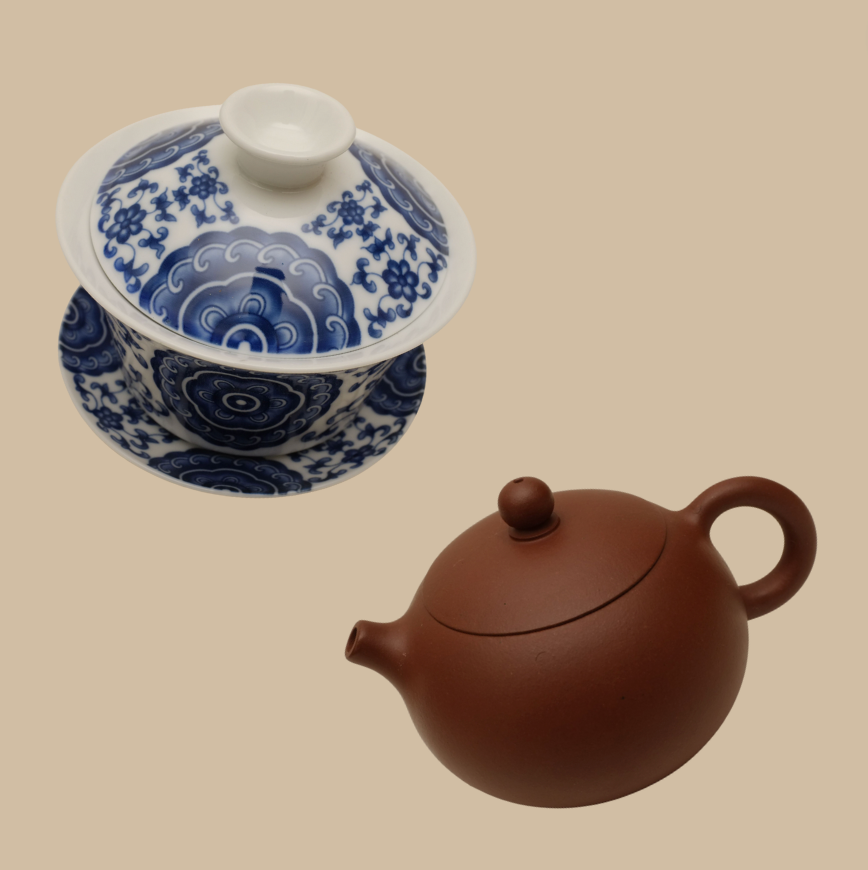Much of the teawares used today are ceramic-based. While glass and metal teaware are also popular, in this article we focus on two historically significant teaware types, clayware and porcelain.
In this Debunking Teware series, we hope to help you understand your teaware on a deeper level and feel confident exploring the many options available to enjoy your tea!
Porcelain
Porcelain is ceramic made from materials such as kaolin (Gao Ling), feldspar, or quartz, etc. Jing De Zhen is the most prestigious city for this style of ceramic in China. Porcelain is a classic and user-friendly material for teaware, as it is very stable and does not interfere with the taste of your tea. Because of it’s density, the teaware is consistently easy to clean, prologing it’s original aesthetic. China is particularly known for its fine porcelain. One theory for the connection between China and china (porcelainware) is that the name might come from the ancient name of Jing De Zhen - Chang Nan. Porcelain is used for many items beyond Gai Wans and teapots, such as plates, bowls, vases, and decorative pieces.
The final porcelain piece’s color depends on the raw material and chosen glaze, but many teaware you’ll find today are whiteish. This allows people to appreciate the liquor of loose leaf tea more intricately, a practice that was brought into vogue in the Ming Dynasty. It has a higher and smoother density than clayware and is fired at a much higher temperature - over ~1200C (~2200F). Fire temperate is a key difference that separates porcelain and clayware.
Porcelain can be as thick as an artist desires, but typically we see a style of very thin porcelain pieces. Thin-walled teaware with a translucent quality are seen as the most luxurious and elegant, with delicate fluidity and smoothness.
Clayware
Clayware is one of the most basic and widely used ceramics, in people’s everyday life around the world. If you join a ceramics class at your local pottery studio, most likelyl you’ll be making a clayware. Historically, some of the oldest ceramic pieces are made out of the simple firing of soil. Soil remains the most common ingredient in clayware, so it tends to come in earthy colors like red, grey, brown, and cream. Aesthetically, clayware is rustic with a sense of primitive desire. Its sturdiness grounds the pieces back to nature and gives them an earthy feeling. Also because of it’s porous nature, clayware shows teaware’s use and age more prominently than porcelain, adding another dimension to it’s artistic and sentimental value.
Clayware typically gets fired at very low temps, ~800C (~1500F). The clayware goes through less shrinkage when firing at lower temperatures, causing it be more porous, and have a lower density. An advantage of clayware is that the pieces can go directly on a fire. We recommend glazed clayware for food-safety.
Okay, but what about purple clay teapots?
Purple clay is more specific than typical clayware made from soil and has a lot more nuances to get into. We’ll dive deeper into it in a later edition of the Debunking Teaware series.
Purple clay is unique in that the firing temperature typically ranges from 1000-1200C (1800-2200F), making it have characteristics of both earthenware and porcelain. Unlike earthenware, teaware made from purple clay is usually unglazed. They are dense, and yet still porous. They’re breathable with the potential to develop a patina, and the wide range of craftsmanship has created a culture revolving around the aesthetic and the collectibility of purple clay teapots. From wheel-thrown like Chao Zhou teapots or handbuilt like Yi Xing teapots, it’s been a popular material for teaware since the late Ming Dynasty. Traditionally, tea pets are often made out of scraps of this material, rendering it’s sentimental value.
Teapots of this material can be more high maintenance, as their porous nature can interfere with the taste of the tea and allow residue to build up over time.
So which style is right for you?
The selection is the drinker’s preference, but you can consider aesthetics; are you feeling more rustic or pristine? Do you want a heftier, thick piece, or thinner, lighter and more delicate? Ultimately both options can serve as a great brewing vessel!
Another factor to consider is the weight of different materials. Teaware made from porcelain tend to be lighter, putting less strain on one’s wrist when handling, whereas clayware tends to be heaving with a more grounding feeling.
While porcelain is theoretically harder than clayware, there’s really no practical benefit one way or the other about durability - if you drop either on a hard surface, it’s probably going to break.

